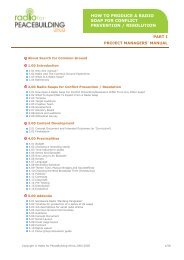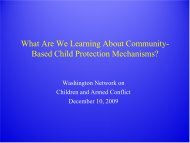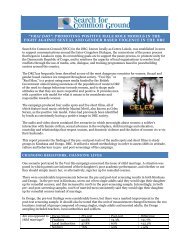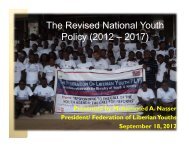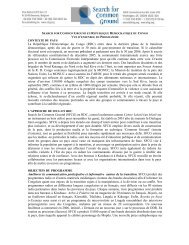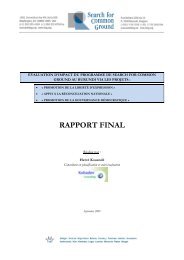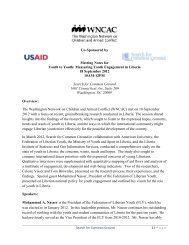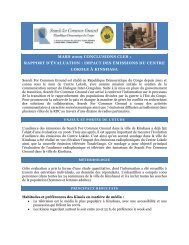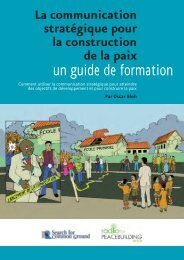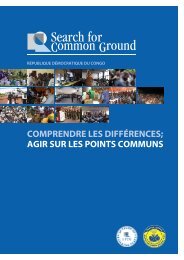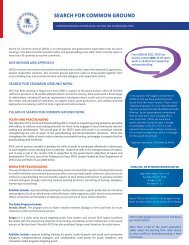The Common Ground Network for Life and Choice Manual
The Common Ground Network for Life and Choice Manual
The Common Ground Network for Life and Choice Manual
You also want an ePaper? Increase the reach of your titles
YUMPU automatically turns print PDFs into web optimized ePapers that Google loves.
to the prevention of teen pregnancy. Ask participants to include in<strong>for</strong>mation about what makes the<br />
program/approach effective; to whom it is targeted; <strong>and</strong> how it addresses a cause of teen pregnancy.<br />
Recorders should create a list on newsprint of the name of the program <strong>and</strong> the person who mentioned<br />
it. Meanwhile, make sure that another more detailed list is created on writing paper that includes the<br />
name of program, a one-line description, contact person, phone number, address (if known), <strong>and</strong> the<br />
name of the person who identified it. This list can be developed by the facilitator, a volunteer<br />
participant, or by passing a tablet around <strong>and</strong> having participants write down their own notes.<br />
6. Concluding comments<br />
Tell the group that this will be the last time that they will meet together, <strong>and</strong> ask members what they<br />
would like to communicate to one another about their work together.<br />
7. At the conclusion of this session, each group should have prepared two lists:<br />
A. A list of common causes <strong>for</strong> teen pregnancy, along with the desired solutions/outcomes;<br />
B. A list of effective programs/approaches.<br />
11:00-11:15: Break<br />
During this time, the causes/desired solutions newsprints are posted in one section of the large room, while<br />
those listing effective programs/approaches are posted in another section.<br />
11:15-12:30 PM: Large group session (Lead Facilitators)<br />
1. Sharing effective programs/approaches (20 minutes)<br />
Participants are asked to describe a program or approach that they heard about in their small groups<br />
that they found to be particularly interesting, innovative or otherwise deserving of mention. Reassure<br />
participants that a list of all the programs mentioned in the small groups will be recorded <strong>and</strong> sent out<br />
with the meeting report.<br />
2. Small groups "report outs" (20 minutes)<br />
Receive reports (2 minutes or less) from each small group on areas of common causes/desired<br />
solutions. All of the newsprint reports are posted on the wall by the end of this session.<br />
3. Prioritizing desired solutions/outcomes (30 minutes)<br />
Distribute 3 dots to each participant <strong>and</strong> ask them to place their dots on the desired solutions/outcomes<br />
that they would most like to see happen as a result of the dialogue. Participants can distribute their<br />
dots in any fashion they choose. Alert participants that placing dot(s) next to an item does not obligate<br />
them to work on that item.<br />
Once this activity is completed, encourage participants <strong>and</strong> facilitators to determine which desired<br />
solutions/outcomes have generated the largest interest through looking at the patterns created by the<br />
dots. Together the group creates a list of its “top” solution categories, which is recorded on fresh<br />
newsprint.<br />
4. Forming working groups (10 minutes)<br />
Explain that "working groups" will now be <strong>for</strong>med – with one "working group” assigned to each<br />
category. Ask participants to take a minute to decide which category they would like to work on. In<br />
the meantime "placards" are prepared, each emblazoned with the name of one of the categories.<br />
Small group facilitators are now each h<strong>and</strong>ed a placard <strong>and</strong> dispersed to different sections of the room.<br />
Participants are asked to choose a category by coalescing around the facilitator with the appropriate<br />
placard. Make sure each group knows where to meet be<strong>for</strong>e breaking.<br />
12:30-1:00: Break <strong>and</strong> pick up lunch.<br />
During this time facilitators/staff strategize concerning the facilitation support needed <strong>for</strong> each group,<br />
<strong>and</strong> review how things are proceeding.



